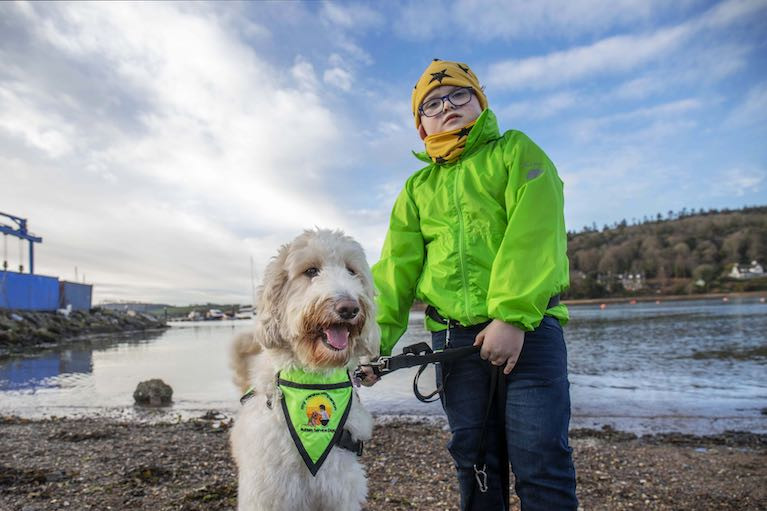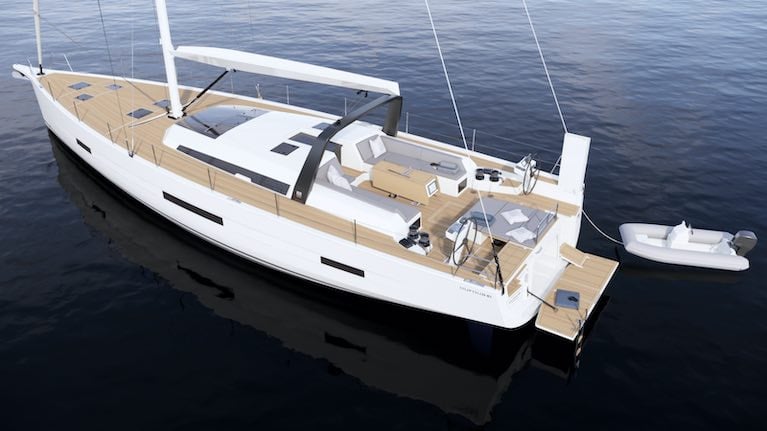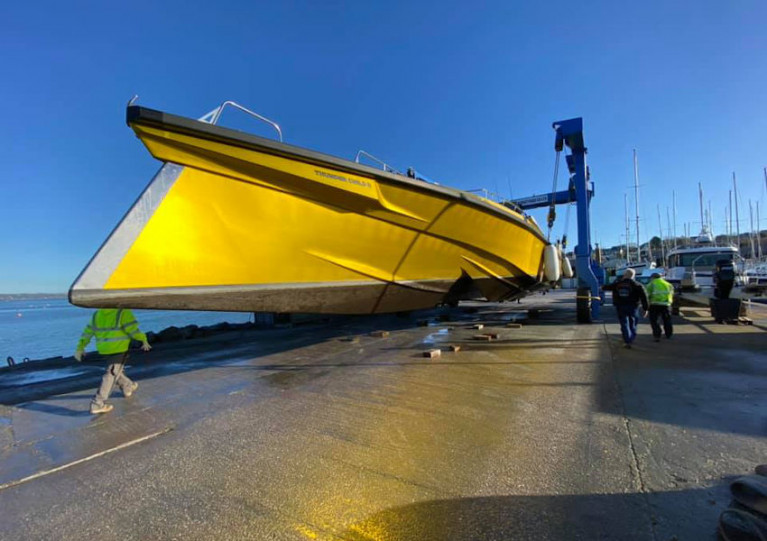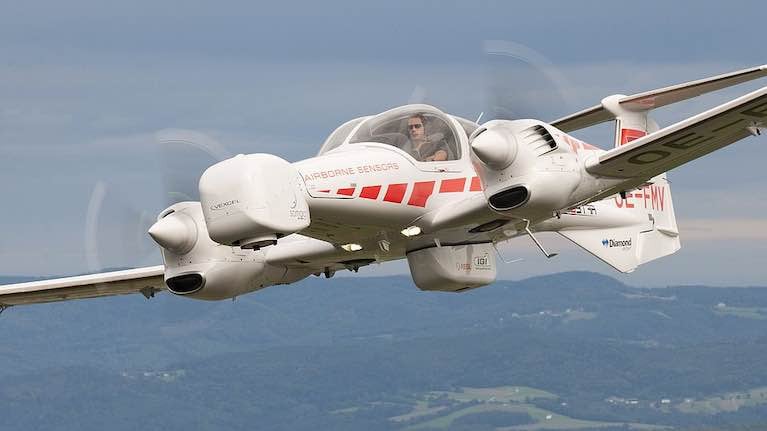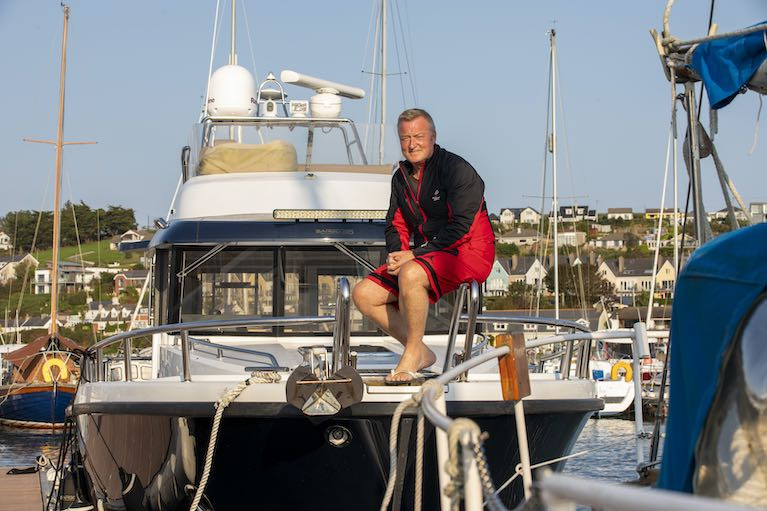Displaying items by tag: Crosshaven Boatyard
Crosshaven Boatyard To Launch New Dufour 44 at Boot Dusseldorf as French Builder Celebrates 60th Birthday
This month's boot Dusseldorf will be special for French Manufacturer Dufour, who will celebrate its 60th anniversary and the World Première of the Dufour 44.
“The launch of the new Dufour 44 is very exciting and follows the very successful launch of the Dufour 41 last year. Both the 41 and 44 are amazing boats because of their performance and volume. Their modern and aggressive styling is a sign that they mean business,' says Irish agent Hugh Mockler of Crosshaven Boatyard.
"They are head turners and would certainly be easy to handle in Irish waters by a couple", Mockler says about the new marques.
boot Düsseldorf 2024 runs from 20-28 January and is one of the largest marine events in the world, with over 2,000 exhibitors across 17 halls.
Dufour will have three models on display at Boot Dusseldorf: 41, 44, and 530. Hugh Mockler will be on hand at the last weekend of the show from Friday to Sunday to show you around.
For more information, contact Hugh Mockler at Crosshaven Boatyard.
Crosshaven Boatyard Launch Rodman's New 690 Ventura CC at Southampton
Rodman's Irish agent, Hugh Mockler of Crosshaven Boatyard, is sharing news of the world launch of a new range from the Rodman Shipyard at the Southampton International Boat Show 2022 this week, where they will have the first model, the Rodman 690 Ventura CC on display.
This new range of outboard boats, from 6-8m in length, will have models available in different deck versions; open with centre console, open with forward cabin and hard top.
In designing this range, Rodman set out to provide a boat that would be accessible to all, aiming to both attract a younger client who might be new to boating, or who wants a sporty boat that compliments an active lifestyle, as well as satisfying the more traditional customer who values comfort and safety.
"The new Rodman 690 Ventura CC is the perfect choice for an affordable day boat that is well suited to all coastal and inland waters across the UK and Ireland, with maximum comfort, great features and the excellent seakeeping expected from Rodman boats", Irish agent Hugh Mockler told Afloat.
The new Rodman 690 Ventura CC will be on display on the Marina at the Southampton International Boat Show 2022, on berth M151. This boat has a 6.5 m hull length and 7.7 m length overall, with a 2.55 m beam. Category C for 6 people (or D for 8) the boat can be fitted with a single outboard engine up to 200hp, and the boat on display at the show has reached speeds of almost 40 knots in sea trials.
 On deck on the Rodman 690 Ventura CC, you will find two distinct areas - the aft cockpit and the forward bow. The cockpit has a rear seat option, which can be completed with a side module and a table. The helm and co-pilot seats will also swivel to face your guests. There is the option of covering this area with an extendable bimini-type sun canopyForward, this new model also offers a second seating area, which can be equipped with cushions and seats, another table and there is also the possibility of turning the entire surface into a solarium. This area can also be covered with a fixed sun canopy. Safe and comfortable movement between the two areas is guaranteed by wide, identical lateral passageways on both sides, one of the hallmarks of all Rodman boats
On deck on the Rodman 690 Ventura CC, you will find two distinct areas - the aft cockpit and the forward bow. The cockpit has a rear seat option, which can be completed with a side module and a table. The helm and co-pilot seats will also swivel to face your guests. There is the option of covering this area with an extendable bimini-type sun canopyForward, this new model also offers a second seating area, which can be equipped with cushions and seats, another table and there is also the possibility of turning the entire surface into a solarium. This area can also be covered with a fixed sun canopy. Safe and comfortable movement between the two areas is guaranteed by wide, identical lateral passageways on both sides, one of the hallmarks of all Rodman boats
This new model is completed by a comfortable console interior, with comfortable access and wide stowage space with the option to fit a chemical toilet.
Don’t Miss the Latest Dufour Nautic Days Event This Week — Plus More at the South Coast Boat Show
With the cancellation of boot Düsseldorf back in January and other boat shows due to COVID, Dufour Yachts have been making more use of online events to showcase its range of yachts.
Following the first two events in its Dufour Nautic Days series, the French brand will hold its third this Wednesday 30 March.
Click HERE to register your interest and find out more about the event.
The programme will include Nicolas Bérenger, Dufour commercial director and Figaro sailor, taking us on board a new Dufour to talk about the pleasure of helming, DNA and reactivity.
There are eight models in the Dufour range including the latest models, the Dufour 32 and Dufour 61 at either end of the range.
The new-look, Felci-designed Dufours are well known for their performance and quality. So it should be no surprise that the order book is almost full for the 2023 season already.

Adding to that demand will be the Dufour 430 and Dufour 390 which will join the line-up of performance cruising yachts at the South Coast Boat Show in Southampton on 6-8 May.
This is a great opportunity to get an insight into the Dufour range in person, as both yachts borrow styling, design features, equipment and smart layout ideas used in their larger and smaller sister yachts.
Crosshaven Boatyard are the Irish agents for Dufour Yachts. Get in touch with Hugh Mockler or Donal McClement on 021 483 1161 or email [email protected].
Get to the Head of the Queue with Dufour's Autumn Offers Through Crosshaven Boatyard
Dufour Yachts and Crosshaven Boatyard are back with a bang at Southampton Boat Show, presenting five yachts, including the fabulous new Dufour 470 and the Dufour 56.
Crosshaven Boatyard is announcing amazing Boat Show 'bundle' offers for all yacht orders placed at the show or before 31 November. These free equipment packs are worth between €10,000 and €50,000, depending on the model, and will enhance the features, onboard facilities and the overall value of your new Dufour.
Hugh Mockler of Crosshaven Boatyard explains, "The demand for new yachts has increased everywhere and our amazing value Autumn equipment bundles are timed to help owners secure a new build slot for Autumn 2022 for guaranteed sailing in the 2023 sailing season. Plus, they will benefit from fabulous free extras, such as enhanced sail controls, additional electronics and audio equipment, interior and cockpit furnishings.
 Dufour 470
Dufour 470
Dufour Yachts are also taking every precaution for show visitors to have a safe and comfortable visit and are running a private appointment system. These half-hour slots mean visitors can view a boat at their leisure and speak directly with one of the team. Book a viewing slot here https://bit.ly/2YAt5KB
The free high spec equipment bundles with all Dufour Yachts ordered at the Southampton Boat Show – berths M315-325
 Dufour 470
Dufour 470
Dufour 470 Launch Shows Off 'Enormous Cockpit' of New French Yacht Model
Recently launched in La Rochelle, the new Dufour 470 model will tour France and then Europe, as well as the United States, Australia and Asia in its worldwide launch.
"The 470 represents continuing advancements with the Dufour range of yachts", according to Irish agent Hugh Mockler of Crosshaven Boatyard who told Afloat "the cockpit is enormous and well thought out as is her interior".
 The Dufour 470 feels and looks like a 50 footer both inside and out
The Dufour 470 feels and looks like a 50 footer both inside and out
If not yet in the flesh, then Paris Virtual Nautic is the first opportunity at least to visit this new model thanks to an on-screen boat show environment using the Dufour virtual Marina interface launched last April, and now optimised with new features and layout choices.
Cork Harbour based Mockler also says of the new marque, "she feels and looks like a 50-footer both inside and out. Like her sisters, she is quick and easy to handle".
 Dufour 470 - cockpit is enormous and well thought out as is her interior
Dufour 470 - cockpit is enormous and well thought out as is her interior
Mockler also says her list of options are endless which means you have the opportunity to have her set up for easy cruising or for even more performance.
Delivery times are already moving rapidly into 2022, Mockler says.
Green Rebel Marine has joined forces with My Canine Companion to support families around Ireland living with autism.
My Canine Companion is an Irish charity that provides accredited service dogs to people with disabilities, predominantly autism. In addition, they provide a range of therapy dog services and autism awareness programmes. They are the largest provider of this service in Ireland with the highest success training rate.
Mark O’Reilly from Green Rebel Marine said: “We are delighted to be able to support the fantastic work of My Canine Companion. Service Dogs make dramatic differences in the quality of life for children with Autism and their families. We are looking forward to working together this year and helping families all around Ireland.”
CEO of My Canine Companion Niall Ruddy said: “Our aim is to enhance the quality of life for people with difficulties predominately autism through the provision of highly qualified service dogs. We also have plans to roll out additional group and individual therapy services to complement our current therapy services in schools, nursing homes etc. We will further develop our awareness programmes including our work with Irish towns and communities to help them become not only autism-friendly but autism responsive. Our partnership with Green Rebel Marine is so important to us in these areas as we seek to together improve both autism services and awareness".
My Canine Companion was set up in Blarney Cork in 2011 by husband-and-wife team Cliona O’Rourke and Niall Ruddy. The organisation is now headquartered in Blackpool, Cork and provides a nationwide service including the provision of over 60% of Ireland's autism service/assistance dogs.
Cliona was the first person in Europe to train a dog specifically for a child with autism in 2004. Cliona travelled to Canada to observe the Canadian autism service dog programme before developing the first European programme in Ireland in 2004/2005. Cliona has since helped several European schools develop their programmes.
Annually My Canine Companions provides over 60% of Ireland's service/assistance dogs to children with autism. The balance is provided by Irish Guide Dogs for the Blind 33% and Autism Assistance Dogs Ireland 7%. MCC qualifies an average of 45 autism service dog partnerships per year and currently have 275 working dog partnerships in Ireland. (November 2020).
My Canine Companion does not charge families for the provision of our service dog programmes. However, the cost to the charity of providing their fully qualified service dogs over a two-year programme and continuing lifetime support is €10,000.
Dufour’s New 61 Flagship Goes for Sea Trials in La Rochelle
Dufour’s new Flagship, the sleek-looking Dufour 61 designed by Felci Yacht Design, will be undertaking sea trials in the next few weeks in La Rochelle. The new Dufour 61 will be quick but stable and very easy to handle, according to Irish agent Hugh Mockler of Crossghaven Boatyard in Cork Harbour.
Her sail controls are lead back to each helm station for easy access. Her mainsheet is on an arch which allows a better sheeting angle and keeps it clear of the cockpit. She has an excellent choice of sail configurations, including the option of in-mast furling mainsail and self-tacking jib.
 The Dufour 61's aft cockpit bed and table. There is plenty of seating and sunbathing areas, both around the central cockpit table and on a stunning aft sun-lounger
The Dufour 61's aft cockpit bed and table. There is plenty of seating and sunbathing areas, both around the central cockpit table and on a stunning aft sun-lounger
Her many advantages include a large dinghy garage, spacious cockpit, sunbathing areas, two cockpit tables and large windows giving loads of light to her amazing saloon. She has a number of layout options below including the forward galley which Dufour have perfected with the option of an aft galley. Dufour have also given her an even more luxurious feel below by adding extra soft furnishings and more upmarket fittings. She also has an endless list of option i.e. bow and stern thrusters, generator, water-maker the list goes on!
 Dufour 61's bathing platform, bbq and garage.There is easy access direct to the aft bathing platform and large dinghy garage, suitable for housing a tender and life raft.
Dufour 61's bathing platform, bbq and garage.There is easy access direct to the aft bathing platform and large dinghy garage, suitable for housing a tender and life raft.
Mockler says that as soon as travel restrictions are lifted and travel is safe, it will be possible to set up a sail test in La Rochelle. Dufour’s plan at the moment is to present the yacht at Boot Dusseldorf in April and then undertake a tour of the Mediterranean. The new Dufour 61 with an overall length of 63 feet will certainly turn a few heads”.
 Dufour 61's aft sunbeds. There is plenty of seating and sunbathing areas, both around the central cockpit table and on a stunning aft sun-lounger, situated between the two helm stations, and cleverly designed to also convert into another table with bench seats
Dufour 61's aft sunbeds. There is plenty of seating and sunbathing areas, both around the central cockpit table and on a stunning aft sun-lounger, situated between the two helm stations, and cleverly designed to also convert into another table with bench seats
Design and build process
On smaller yachts, typically their design incorporates an inner matrix system that is bonded to the hull to create the required core strength. With the increased loads of a yacht the size of the '61 it is necessary to create a much stronger, rigid structure that will sail upwind without deflection or movement of the internal components. To create this, the hull has been made from a monobloc structure using an 'infusion process' which allows exact control of the production process. The main bulkheads are made from solid GRP and laminated directly onto the hull and deck, all of which create a highly robust single structure, stiff hull and deck for ultimate sailing performance which Dufour consider essential for a yacht of this size.
Hull & sail plan
Long hull chines offer a stable hull with increased performance as well as creating added volume below decks, all set off with Dufour's signature half-butterfly portholes.
With an overall sail area of 170m2, the yacht is supplied with optional in-mast or a traditional mainsail, self-tacking or overlapping headsails plus options to fly a variety of downwind sails from the integrated fixed bowsprit.
Deck layout
The coach roof ends at the mast base to create a clean and spacious foredeck and wide side decks allow easy movement around the deck. Importantly, the hull to deck joint is fully hidden with the teak side decks elegantly disguising the moulding lines
Numerous hand-holds together with a raised bulwark give greater security when moving around the deck at sea. Integrated in the bulwarks are smart courtesy lights to illuminate the decks at night.
Generous natural light floods below decks through a single moulded black plexiglass roof, which contrasts beautifully with the side decks and coachroof.
Cockpit layout
The cockpit has been carefully designed to separate the functional elements of sailing with other areas offered for relaxation.
All the hidden control lines run under the decks and are led aft to each helm station, both with large seats offering better comfort when sailing and all the necessary instrumentation equipment to ensure safe and easy navigation.
Movement around the cockpit is simple and unhindered, with large, moulded steps integrated into the coaming for safe and easy access up to the side decks.
An innovative split bimini allows easy circulation on board, without ducking or restricted headroom. The black carbon fibre arch clears the cockpit and entrance below as well as allowing the mainsheet control system to be at the end of the boom for less pressure and easier control.
With a spacious cockpit, fully enclosed on both sides, there is easy access direct to the aft bathing platform and large dinghy garage, suitable for housing a tender and life raft.
There is plenty of seating and sunbathing areas, both around the central cockpit table and on a stunning aft sun-lounger, situated between the two helm stations, and cleverly designed to also convert into another table with bench seats. It's the perfect spot, at the back of the cockpit, for breakfast or refreshments after a swim from the generous bathing platform. Beneath this rear bench sits the now legendary Dufour exterior galley, with barbeque, sink and fridge – for relaxed alfresco catering and socialising.
Below decks
The key distinction between the two layouts is the option to choose between a forward or aft galley layout.
In broad terms, the forward galley layout is intended for those owners not requiring a dedicated skipper's cabin aft. Generously appointed, the galley integrates with the main living space enabling sociable catering and hospitality, perfect for hosting families and friends. With a traditional layout of 2 aft double guest cabins, a generous master cabin forward and optional side Pullman cabin, there is also the option for a crew cabin forward, that is accessed from on deck.
Alternatively, the discreetly positioned port side aft galley which leads to a dedicated skipper's cabin, is the ideal layout for onboard catering and hosting. Again, there are additional Pullman cabin options to maximise accommodation.
On all models the master cabin is as luxurious as it is spacious, offering private relaxation space, as well as plenty of large wardrobe and storage cupboards. The beds are full 'home-sized' and come with real mattresses and optional slatted bases for support and ventilation.
Both layouts offer a generous and spacious interior living area and galleys with excellent storage space and a high-capacity fridge/freezer.
As is a now a familiar signature of all modern Dufour models, the cabins and living areas are flooded with plenty of natural daylight through large windows, deck hatches and portholes.
A dedicated navigation table is situated in the main saloon, along with a large bench sofa and an extendable dining table with extensive seating capacity. High quality wood is used throughout with a choice of interior woods and finishes.
Crosshaven Boatyard Appeals to Customers for Patience Under Latest Pandemic Restrictions
With the rise in COVID-19 cases and in line with Government guidelines, Crosshaven Boatyard has no option but to close its gates for the time being.
In a statement on social media, the Cork Harbour boatyard appealed for private boat owners to have patience under the current restrictions, which will remain in place until at the least the end of January.
Those within the 5km travel radius may visit to check on their vessels, but are asked to come alone and not to carry out any works.
“If for any reason you feel the need to have your boat checked, please contact the office and we can arrange one of our staff to do this on your behalf,” the boatyard said, adding that staff will be at hand for emergency haul-outs.
The boatyard will also still support essential services such as commercial fishing, Department of Defence, science and research, the RNLI and Port of Cork.
The team added: “Finally we would like to thank you all for your continued support and we look forward to seeing you all back in the water boating once again. Stay safe.”
Crosshaven Boatyard recently changed hands, and new owner Pearse Flynn shared details of his plans to make its facilities the backbone of offshore wind farm services.
Cork Harbour's Green Rebel Marine Buys Aircraft for Aerial Surveys off the Irish Coast
Green Rebel Marine with a base at Crosshaven Boatyard in Cork Harbour has announced the €1.5 million purchase of a DA42 multi-purpose aircraft to conduct aerial surveys off the Irish coast.
Thousands of square miles of ocean are due to undergo ecological assessment as part of the planning process for offshore wind farms.
The new aircraft will be based at Cork Airport, and will result in the creation of fifteen new jobs. These jobs are in addition to the eighty announced by Green Rebel Marine in September.
With the purchase of its own survey aircraft, Green Rebel Marine will be the only domestic Irish company offering digital aerial surveys for offshore wind development companies.
The twin-engined DA42 MPP is rated as best in class in terms of fuel efficiency and emissions, and is equipped with high-performance aerial cameras to conduct ecological surveys.
Green Rebel Marine was established earlier this year to service the future needs of offshore wind farms. The company has already acquired Crosshaven Boatyard in County Cork, and the first in a fleet of survey vessels, the Bibby Athena.
Plans for offshore wind farms are at an advanced stage with a number of potential fixed and floating operators examining sites along the coast from Dundalk in County Louth, to the Cork coast and beyond. Their construction will not only increase Ireland’s ability to produce renewable energy, it will also create an entire new sector dedicated to servicing their operation.
Sarah Kandrot, Head of Aerial Surveys with Green Rebel Marine, says, “Off-shore energy is part of the green revolution, however the granting of licences for these wind farms is dependent on detailed surveys of the ocean to catalogue the ecology of the target areas. The purchase of this aircraft means that large sections can be digitally surveyed over a shorter period of time, with the aircraft flying at heights that will not disturb birds or marine megafauna. Ultimately, the information we compile will ensure that offshore wind farms are built in the best locations to protect the ecology of the ocean.”
Green Rebel Marine founder Pearse Flynn says, “The purchase of the survey aircraft, along with the first in our fleet of survey vessels, means that Green Rebel Marine is leading the charge towards sustainable and renewable energy off the Irish coast. This is an industry that will sustain thousands of jobs while transforming Ireland into a net generator of electricity. The oceans around Ireland are a vital resource, and the quality survey work being undertaken by Green Rebel Marine will help to both protect that resource while harnessing its potential.”
The Green Rebel Marine aircraft will be permanently based at Cork Airport once it enters full-time operation early next year.
Niall MacCarthy, Managing Director at Cork Airport, said: “2020 has been a tough year for everybody so it’s great to be starting 2021 with a good news story. Recovery and jobs will be THE theme for 2021 and an aircraft based with us in Cork which helps create new jobs particularly in the green energy sector is very welcome. The Green Rebel Marine Diamond Aviation 42 aircraft will be based at the Weston General Aviation Hangar at Cork Airport and we wish them every success in this exciting new offshore wind venture.”
Offshore Wind Farms - What Does Public Consultation Really Mean?
The photomontage published in Afloat a week ago of 60 'supersize' wind turbines planned for Dublin Bay should raise substantial debate about the impact of offshore wind farms on Irish waters and the activities in them – sailing, leisure marine, fishing and commercial.
There are so many proposals now being forward, with billions of Euros involved, in response to the Government's stated intention to drive forward wind energy, that it becomes challenging to keep track of them all. "Public consultation" is promised, but what does that exactly mean and how effective is this process?
The proposal for the Kish and Bray Banks is about six nautical miles offshore, so for many leisure mariners that might not seem to be considered as a major issue, or problem. However, the 60 turbines would be 310 metres in height - over a thousand feet - pretty substantial on the seascape.
 Dublin Array: Likely view from Dún Laoghaire towards Sandycove and out towards the Kish Bank.
Dublin Array: Likely view from Dún Laoghaire towards Sandycove and out towards the Kish Bank.
The Arklow Bank Wind Park, as it's called, is also six miles offshore. Phase 2, for 76 turbines, is under public consultation and there is a lease area 27 km long and 2.5 km wide.
The developers of these and other projects have initiated public consultation. Projects are promoted as essential for energy and environmental purposes, but there is less, if any, reference in publicity to the profits.
So what does "consultation" mean?
Too often, as a journalist, it seems to me that "consultation" is seen by developers as a necessary process to be gone through, indicating that the public has been consulted. But with what effect? Is debate sufficiently focused on the effects on leisure, sailing, fishing, commercial, marine life, species? Is there not a need, in response to the proliferation of proposals, for more widespread debate and more intensive focus, practical discussion and a wider, co-operative approach and not only through the State process administered and controlled by officialdom >
In this regard, I have been talking to the man who has bought Crosshaven Boatyard in Cork Harbour to set up a business "to service the future needs of offshore wind farms." Pearse Flynn of Green Rebel Marine has set up a "strategic partnership" with Fisheries Liaisons Ltd., to develop communication "with the wider marine and fishing community as development of offshore wind farms picks up pace." It seems an interesting approach to "consultation."
Listen to him on the Podcast below.


























